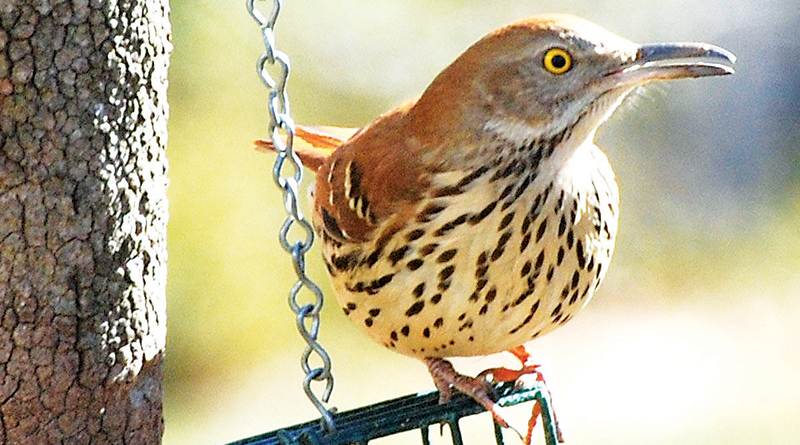MIMIC THRUSHES HAVE DISAPPEARED – Life In The Outdoors

What kind of bird is this, a friend asked, showing me a picture she had of a brown thrasher. I doubt my friend would have asked me the name of that bird many years ago. It was a common summer bird in Iowa where I grew up and in most of the other states of the U.S. east of the Rocky Mountains and of southern Canada. But now, looking at the picture and thinking about it since, I can’t remember the last time I saw a brown thrasher.
This is a bird with a body about the size of a robin but a much longer tail. Male and female are colored alike, reddish-brown on the head, back and tail, light dusty yellow with dark streaks underneath. It has two white wing bars that are conspicuous when the bird is perched.
A brown thrasher is strikingly colored but its song is what attracts our attention. It’s a mimic thrush, a bird of the same family as the mockingbird and it lives up to its classification, mimicking the songs of other birds and many other sounds, usually repeating each phrase making it a double note.
The nest of a brown thrasher is platform of sticks, usually in thick brush or the lower branches of a bushy tree. Adult thrashers are very protective of their nest and their aggressiveness often made me pause when a pair accosted me when I was walking in a woods looking carefully around to find the nest when I was a boy.
By classification the brown thrasher is a mimic thrush, king of the feathered mimics. While the brown thrasher mimics the songs of many birds, the mockingbird copies many other sounds as well as the songs of other birds. I have never made a list of the calls of a mocker but according to one of my books it will crow like a rooster, cackle like a hen, bark like a dog, make squeaking sounds like the sound of a wheelbarrow or wagon that needs to have its wheels oiled, and even make sounds like the playing of a piano or flute or other musical instrument.
In addition to making such a variety of sounds, a mockingbird repeats each sound several times before going on. A male mocker also sings at any time, day or night, when the weather is fair and it has a mate on a nest. I learned about the night-time singing one year when a pair of mockers built a nest in a bush outside my bedroom window. I was in college then and the window of my parent’s house, where I stayed in summer, had no air conditioning. My bedroom was on the ground floor and on warm nights, hot nights, nights when the temperature was 80 or 90 degrees, I had the window open, of course. Like a brown thrasher, I haven’t seen a mocker in several years.
There’s a third member of this remarkable family of birds, the catbird, a uniformly gray bodied bird with darker wings and tail and a black cap. The catbird also has a great variety of songs, or calls, but gives each call just once and it also intersperses the meows of a cat. Its cat calls are often given singly, without any other calls, and from this, and its gray cat color, the catbird gets its name.
I have seen a catbird this year, just one. But, like the brown thrasher and the mockingbird the catbird is now rare though it used to be common. Many species of birds have become uncommon or rare since the days when I saw brown thrashers and catbirds almost daily in summer, mockingbirds occasionally though they were generally a more southern species than my home when I was young.
- Birds As Weather Forecasters – Life In The Outdoors - December 17, 2021
- Rare Bird Spotted In Indiana – Life In The Outdoors - October 8, 2021
- MY EXPERIENCE WITH DEER – Life In The Outdoors - July 30, 2021


